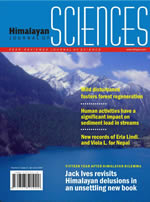How to control illegal wildlife trade in the Himalayas
DOI:
https://doi.org/10.3126/hjs.v2i3.223Keywords:
Wildlife trade, illegalAbstract
Review of Cites Implementation in Nepal and India – Law, Policy and Practice by Ravi Sharma Aryal Bhrikuti Academic Publications, Kathmandu, Nepal, 2004 200 pp, ISBN 99933-673-4-6 NRs 995, US$ 25 (paperback) The international illegal trade in wildlife and wildlife products is one the major engines driving species to extinction. The Convention on International Trade in Endangered Species of Wild Fauna and Flora (CITES), which defines standards for use of wildlife and their products, represents a major global commitment to reverse this trend. It remains to be seen whether the terms of this treaty will be enforced. Focusing on Nepal and its neighbors, Aryal discusses the obstacles to its successful implementation: imprecise legislation, inconsistent policies, lack of coordination among relevant institutions (particularly, those responsible for regulating international trade), and the deadly threat posed by poachers determined to protect their endangered livelihoods. Aryal’s recommendations are detailed, far-reaching, and compelling. Himalayan Journal of Sciences 2(3): 15-16, 2004 The full text is of this article is available at the Himalayan Journal of Sciences websiteDownloads
Download data is not yet available.
Abstract
938
PDF
1476
Downloads
How to Cite
Chaudhary, R. P. (2006). How to control illegal wildlife trade in the Himalayas. Himalayan Journal of Sciences, 2(3), 15–16. https://doi.org/10.3126/hjs.v2i3.223
Issue
Section
Resource Review




